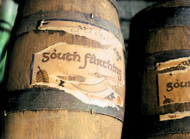Pipe-weed was a plant of Middle-earth, in particular grown and enjoyed much by the hobbits of the Shire, to whom it was introduced by Tobold Hornblower.
History
It was first grown in the Shire by Tobold Hornblower in Longbottom around SR 1070 (TA 2670); however, the technique may have been developed in Bree, and brought to the Shire only after Tobold's visitation there. Despite its foreign origins, the hobbits were the first to use it for smoking. Pipe-weed production became a major industry in the Shire, especially in the Southfarthing.[1]
The same plant was known among the Dúnedain as Sweet Galenas for its fragrance. In Gondor, it was known as Westman's-weed, and grew there as a wild plant, appreciated most for its sweet-scented flowers. The colloquial name was in reference to its origins: it was apparently brought to Middle-earth by the Númenóreans in the Second Age.[2]
Popular Shire-hobbit varieties of pipe-weed soon included: Longbottom Leaf, Old Toby, Southern Star and Hornpipe Twist. They are revered by Bilbo Baggins, and are all grown in the Southfarthing.
A lower quality strain of pipe-weed called the Southlinch was used in the town of Bree. It was named after the hilly fields where it was grown on the south side of Bree-hill.

The wizard Gandalf learned to smoke pipe-weed from the Hobbits and was known to blow elaborate smoke-rings. Saruman initially criticized him for this, but eventually secretly took up smoking himself. After the destruction of Isengard, pipe-weed was found among its stores, but the hobbits Merry and Pippin realized only later the implications of the discovery of Saruman's commerce with the Shire.[3]

See also
Translations
| Foreign Language | Translated name |
| Afrikaans | Pyp gras |
| Albanian | Bari i tubave |
| Amharic | የፓይፕ-ሣር |
| Arabic | عشب الأنابيب |
| Armenian | Խողովակների խոտ |
| Assamese | পাইপ ঘাঁহ |
| Azerbaijani | Boru-ot |
| Belarusian Cyrillic | Трубавая трава |
| Bengali | পাইপ ঘাস |
| Bulgarian Cyrillic | Тръбна трева |
| Cambodian | ស្មៅបំពង់ |
| Catalan | Herbes de pipa |
| Chinese | 管草 |
| Croatian | Trava za lulu |
| Czech | Roura bylinkový |
| Danish | Pibe urt |
| Dogri | पाइप घास |
| Dutch | Pijpkruid |
| Estonian | Toru-rohi |
| Finnish | Piippukessu |
| French | Herbe à pipe |
| Frisian | Piip gers (Western) |
| Georgian | მილის ბალახი |
| German | Pfeifenkraut |
| Greek | Χόρτο σωλήνων |
| Gujarati | પાઈપ ઘાસ |
| Hebrew | עשב המקטרת |
| Hindi | पाइप घास |
| Icelandic | Pípugras |
| Indonesian | Pipa-rumput |
| Irish Gaelic | Féar píopa |
| Italian | Erba Pipa |
| Japanese | パイプ草 |
| Kannada | ಪೈಪ್ ಹುಲ್ಲು |
| Konkani | नळयेचें तण |
| Korean | 파이프 잔디 |
| Kurdish | (Sorani) چیمەنی بۆری Giya boriyê (Kurmanji) |
| Laotian | ຫຍ້າທໍ່ |
| Latvian | Cauruļu garšaugi |
| Lithuanian | Vamzdžių žolės |
| Macedonian Cyrillic | Цевни билки |
| Malagasy | Ahitra sodina |
| Malayalam | പൈപ്പ് പുല്ല് |
| Malaysian | Rumput paip |
| Maltese | Ħaxix tal-pajp |
| Mongolian Cyrillic | Хоолой-өвс |
| Nepalese | पाइप-घाँस |
| Norwegian | Pipeurt |
| Pashto | پایپ واښه |
| Persian | چمن لوله |
| Polish | Fajkowe ziele |
| Portuguese | A grama de Tubulação (Portugal) Erva de fumo (Brazil) |
| Punjabi | ਪਾਈਪ ਘਾਹ |
| Romanian | Larba de țeavă |
| Russian | Трубочное зелье |
| Sanskrit | पाइपतृणम् |
| Scottish Gaelic | Feur pìoba |
| Serbian | Трава-за-лулу (Cyrillic) Trava-za-lulu (Latin) |
| Sindhi | پائپ گھاس |
| Sinhalese | පයිප්ප තණකොළ |
| Slovak | Potrubná tráva |
| Slovenian | Cevna trava |
| Somali | Cawska tuubada |
| Spanish | Hierba para pipa |
| Swahili | Nyasi ya bomba |
| Swedish | Rörgräs |
| Tajik Cyrillic | Алафи қубур |
| Tamil | குழாய் புல் |
| Tatar | Торба үләне |
| Telugu | పైప్ గడ్డి |
| Thai | หญ้าท่อ |
| Turkish | Boru otu |
| Turkmen | Turba otlary |
| Ukrainian Cyrillic | Трубова трава |
| Urdu | پائپ گھاس |
| Uzbek | Қувур ўти (Cyrillic) Quvur o'ti (Latin) |
| Vietnamese | Cỏ ống |
| Yiddish | רער גראָז |
References
- ↑ The Lord of the Rings, Prologue, II: "Concerning Pipe-weed"
- ↑ The Lord of the Rings, The Return of the King, Book Five, Ch. VIII: "The Houses of Healing"
- ↑ The Lord of the Rings, The Two Towers, Book Three, Ch. IX: "Flotsam and Jetsam"